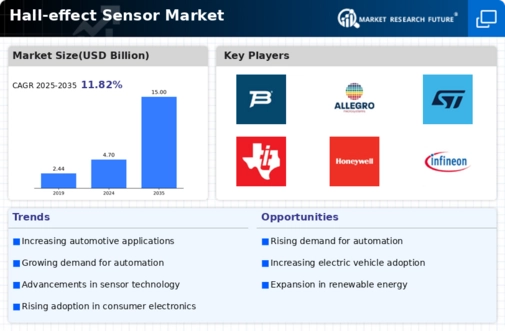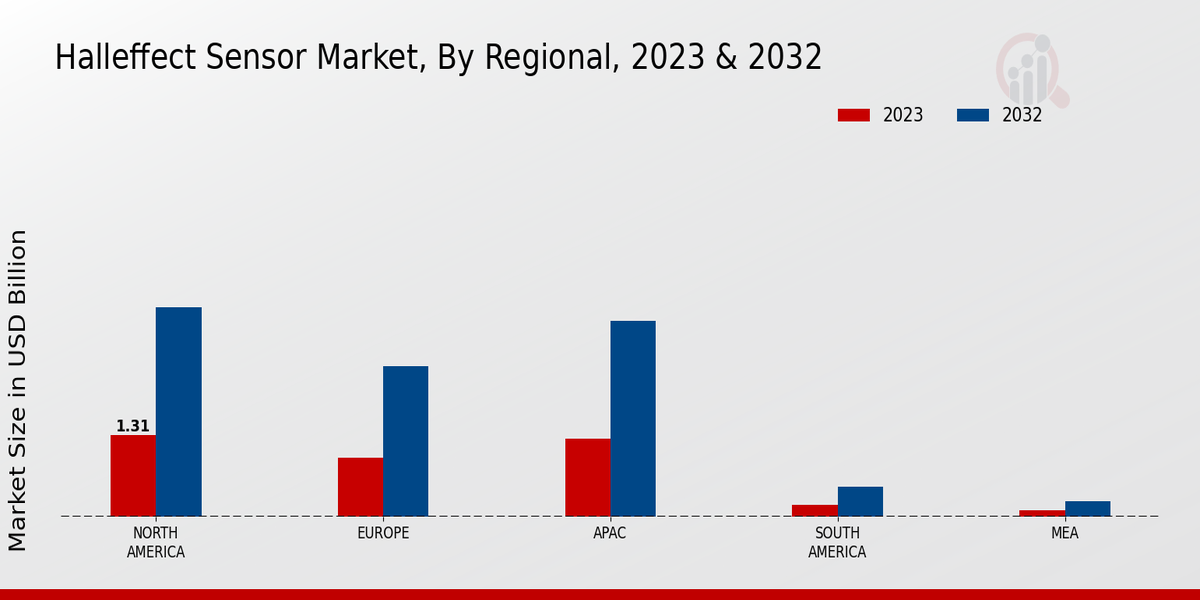The Hall-effect Sensor Market is experiencing noteworthy growth driven by the increasing demand for automation in various industries. Factors such as the rise in electric and hybrid vehicles significantly contribute to this trend, as these sensors are essential for improving the efficiency of engines and monitoring various parameters. Also, the rapid integration of various smart technologies in consumer electronics is boosting market demand as Hall-effect sensors provide reliable and accurate performance metrics.
The automotive sector continues to be a primary application area, coupled with the industrial sector focusing on process automation and robotics, further fueling market expansion.Opportunities within the market are evident, especially as industries seek improved efficiency and safety through advanced sensor technology. The rising adoption of IoT devices presents a substantial growth area, offering avenues for innovation in sensor applications across smart homes and connected devices. As industries strive for better performance and reduced energy consumption, the demand for more sophisticated Hall-effect sensors is likely to expand.
Furthermore, untapped markets in developing regions may present significant opportunities for growth as these areas invest in modernizing infrastructure and increasing automation in manufacturing processes.Trends in recent times indicate a shift towards miniaturization and integration of Hall effect sensors into multifunctional devices. There is also a growing emphasis on developing sensors that are more sensitive and capable of functioning in extreme environments. The trend towards sustainability is pushing manufacturers to focus on eco-friendly production processes and materials, aligning with global initiatives for reducing carbon footprints.
Additionally, advancements in wireless technology are promoting greater flexibility in sensor applications, indicating a positive trajectory for market evolution. Overall, the interplay of these factors creates a vibrant landscape within the Hall-effect Sensor Market, promoting continuous innovation and expansion.
Hall-effect Sensor Market Drivers
Increasing Adoption of Electric Vehicles
The growing demand for electric vehicles (EVs) is a significant driver for the Hall-effect Sensor Market Industry. As EV manufacturers seek efficient ways to enhance performance, optimize battery management systems, and improve overall vehicle safety, Halleffect sensors play a crucial role. These sensors are vital for various applications, including wheel speed detection, position sensing, and battery monitoring. The shifting consumer preferences towards sustainable transportation solutions lead to advancements in automotive technologies, making Hall-effect sensors an essential component.The evolution of stringent environmental regulations further compels automakers to adopt electric vehicles, thereby bolstering the demand for Hall-effect sensors.
With the projected growth of the electric vehicle segment, the need for innovative sensor technologies is expected to surge, propelling the Hall-effect Sensor Market.
Additionally, the collaboration between automotive manufacturers and technology firms will result in the development of advanced sensor systems that will enhance electric vehicle functionalities, ultimately contributing to a holistic improvement in performance and user experience.The increase in consumer awareness about environmental issues, coupled with government incentives for EV purchases, ensures sustained growth in this sector, driving the demand for Hall effect sensors robustly.
Rising Use of Automation in Industrial Applications
The rise in automation across various industries serves as a substantial driver for the Hall-effect Sensor Market Industry. As industries strive to enhance efficiency, reduce labor costs, and optimize processes, the integration of advanced sensors, including Hall-effect sensors, becomes inevitable. These sensors are instrumental in various automation applications, such as position sensing, speed detection, and proximity sensing. With Industry 4.0 shaping the future of manufacturing, the demand for precision and accurate sensing solutions is paramount.Companies are increasingly investing in automated systems that rely on these sensors for real-time monitoring and control of industrial processes.
As factories transition towards smart manufacturing and interconnected systems, the relevance of Hall effect sensors continues to grow, reinforcing their demand in the market.
Growth of Consumer Electronics
The proliferating consumer electronics market significantly contributes to the expansion of the Hall-effect Sensor Market Industry. With technological advancements leading to the development of smart appliances and devices, the integration of Hall effect sensors has become more prevalent. These sensors facilitate essential functions in electronics, such as magnetic field detection, for functionality and efficiency. The surge in demand for smart homes, wearable devices, and IoT-enabled gadgets creates numerous opportunities for sensor applications. As manufacturers compete to offer innovative and feature-rich products, the necessity for high-performance sensors like Hall-effect sensors increases, thereby driving market growth.
Hall-effect Sensor Market
The ongoing advancements in automotive and industrial applications are driving a notable increase in the adoption of Hall-effect sensors, reflecting a broader trend towards enhanced efficiency and precision in electronic systems.
U.S. Department of Energy





















